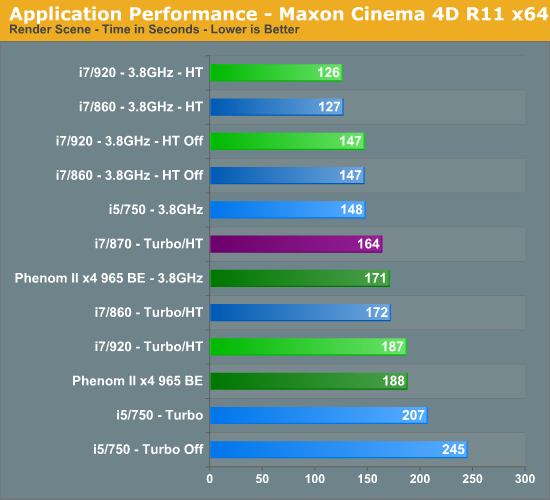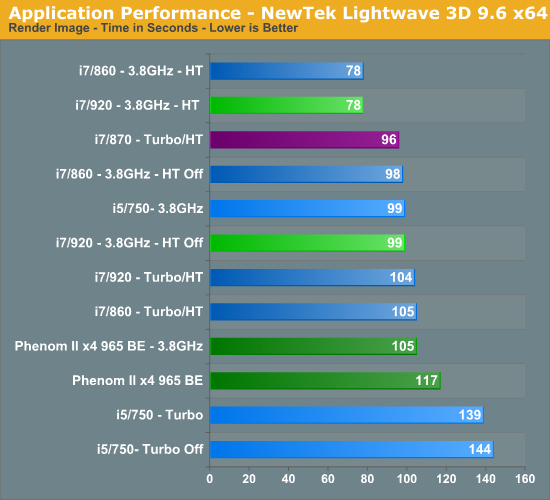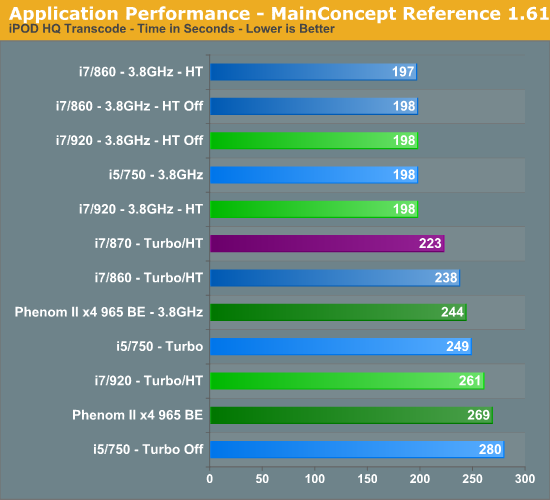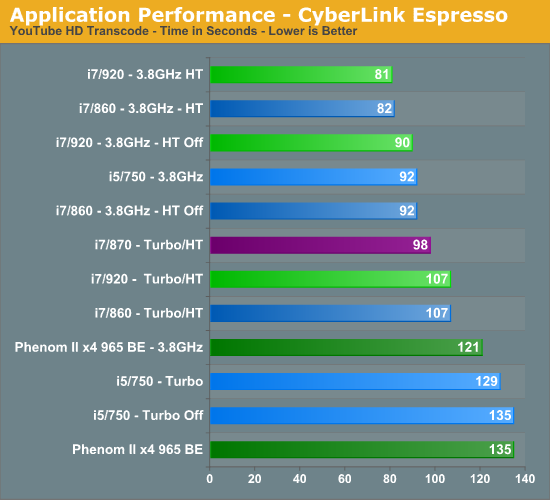i5 / P55 Lab Update - Now with more numbers
by Gary Key on September 15, 2009 12:05 AM EST- Posted in
- Motherboards
Applications-
Cinema 4D R11 x64
Cinema 4D R11 is one of our favorite programs to create high-end 3D images and animations. This particular program is sensitive to memory bandwidth and is well threaded. We track the time it takes to render a swimming pool layout.

Our i7/920 finishes first with the i7/860 just a second behind at 3.8GHz and with HT enabled. Disabling HT decreases performance 15% when these two CPUs are overclocked. The 965 BE is 27% slower at 3.8GHz than the i7/920 with HT enabled and 14% with HT disabled.
Turbo mode benefits the i5/750 greatly in this benchmark as turning it off results in the 750 being 16% slower. However, pure CPU speed allows the 965 BE to finish the benchmark about 10% quicker than the 750 with Turbo enabled and 23% with Turbo disabled with a 28% higher base clock speed. Of course, the 965 BE is 17% more expensive based on CPU cost comparisons.
LightWave 3D 9.6 x64
Another popular 3D rendering program is Lightwave 3D 9.6. In this test we time the rendering of a single frame from an office building animation. The time to render the full scene is approximately four and a half hours. This title is also well threaded and sensitive to both memory bandwidth and latency.

Lightwave also favors HT enabled processors with the 860/920 tying for first at 3.8GHz. Interestingly enough, Turbo mode on the i5/750 only offered a 3% improvement in this bench. The 965 BE scales very well as a 11% core speed increase nets a 10% improvement in the benchmark. However, the 965 BE still trails the 860/920 CPUs by 26% at 3.8GHz.
MainConcept Reference 1.61
One of our favorite video transcoding utilities is MainConcept Reference. We set our profile to iPOD HQ NTSC and then transcode a 651MB 1080P file to an iPOD HQ 34.7MB file.

HyperThreading does not make a difference in this title with the 860/920 finishing in a dead heat again. Turbo mode for the i5/750 improves its scores by 11%. Once again, the 965 BE scales very well with an 11% increase in speed resulting in a 9% benchmark improvement. Otherwise, the 965 BE trails the 860/920/750 by 29% at 3.8GHz.
Sonar Producer 8 x64
We utilize Sonar Producer extensively at home when mixing various music tracks. This test performs a complex mix of five individual tracks into a single title. We covert these tracks into a WAV format utilizing a 192kHz sample rate along with all other options enabled. This title thrives on memory bandwidth.

We finally see some separation between the 860 and 920 processors in this benchmark. Based on offline memory testing, we contribute this to the 920’s slightly better throughput under load conditions. The i5/750 performs 13% better with turbo enabled. The 965 BE performs 15% worse than the 750 at 3.8GHz.
Adobe Lightroom 2.4 x64
Lightroom is a quick and easy to use program for batch conversions on digital photos. We perform a standard conversion of 50 RAW images into the JPEG format.

HyperThreading does not matter in this title. The 920 finishes just slightly ahead of the 860. Turbo mode makes 9% difference for the i5/750, just enough to place ahead of the 965 BE at stock speeds. Once overclocked, the 965 BE is 17% slower than the 750.
CyberLink MediaShow Espresso
We transcode a 370MB 1080AVCHD file into a HD friendly file suitable for publishing on YouTube. This program features GPU hardware accelerated decoding via ATI Stream or NVIDIA CUDA but is disabled in our test routines.

Even with a 740MHz advantage in clock speed, the 965 BE is just equal to the i5/750 with Turbo disabled in this application. Obviously, it appears this particular program behaves differently on Intel processors. Even at a 3.8GHz clock speed, the 965 BE trails the i5/750 by 24%. The 920/860 processors continue to be close, even though in this application the 920 has a slight advantage.










77 Comments
View All Comments
glenster - Wednesday, September 16, 2009 - link
Another consideration for comparison is that the Core i7 960 3.2GHz is due Q4 2009 for $562--see Wikipedia > Nehalem > 45 nm processor architecture. Another site says it's due Oct.18.grimpr - Tuesday, September 15, 2009 - link
Its always fun to watch cases of reversal...in this case, that the AMD/Nvidia combination is proven superior to the gamers and the oems market favorite Intel/Nvidia combo. We can sense the suspicions, fear and doubt on Garys comments and we wait more from him for our further enjoyment. Gary, keep on the Intel crusade...Gary Key - Tuesday, September 15, 2009 - link
There is no fear or doubt, just a quest to figure out why there is such a difference between the NV and AMD GPUs on each platform. If you are an Intel crusader I guess your suspicions would lead you to believe that NV is dogging performance on the Intel platforms.If you are an AMD crusader, you would think AMD is dogging performance on their own platform. Think about that for a moment. I seriously doubt either company is dogging it as they both depend heavily on GPU sales for their survival.
Please read this and just about any other article I have written on AMD and tell me if you really believe I am on an Intel crusade - http://www.anandtech.com/mb/showdoc.aspx?i=3506">http://www.anandtech.com/mb/showdoc.aspx?i=3506 . ;) I care about the best possible performance for the best possible price, with a dash of support thrown in. No hidden agendas around here and if you think so, you would be wrong.
yacoub - Tuesday, September 15, 2009 - link
The rest of us know it's not the case, Gary, but the trolls are just tossing out bait to get you to bite. Ignore 'em.lopri - Wednesday, September 16, 2009 - link
For real. If the test was done using dual-channel on X58 there'd be a huge outrage from certain users how X58 was arbitrarily disadvantage.I have no idea why Gary felt the need to defend himself. Any reasonable reader who followed his articles should know he is the most trust-worthy journalist, bar none. Plus many other writers who know alot about technology but don't know how to write, He is a rare case who actually can write. Look at the first sentense of this article: "We welcomed Anand back into the office with open arms this past weekend." This brought a smile in my face and you can't help but feel disarmed and charmed.
Dispite it being short, the amount of information in this article is simply overwhelming. What's more, it is apparent that the testings were pursued from actual users' perspectives. Arrogant, nasty, and sensational analysis might help raising controversies (and page views), but in the end what benefits us enthusiasts most is these painstaking and seemingly mundane tests that the author undertakes on behalf of the readers.
Still, as is often the case, Gary choose to be modest than aggrandizing ("Quick Thoughts" instead of "harder, deeper, baby!" / "choice for me" instead of "Dark knight to rescue the civilization"), and I am very satisfied to find myself identifying with the author as a potential user with regard to the testing methodology. Plus, seemingly impossible multitasking tests on top of myriads of the configurations tested substantiate the author's subjective opinion significantly, and I for one am very grateful that someone else took all that beating!
Now if I could make a request that could possibly make the author's life even more miserable - any chance to add virtualization to the multitasking mix? With the introduction of XP mode in Windows 7, I think the time has finally come that virtualization has some relevance to desktop users.
TA152H - Tuesday, September 15, 2009 - link
Gary,There are a couple of missing data points that would be helpful, and you probably should include with every article regarding benchmarks.
What were the uncore rates on these processors? Were the i7 920 and 860 running with the same uncore speed?
Also, were you using the D0 i7 920, which offers slightly higher performance, lower power use, and better clock speed potential, or the older C0?
Lastly, do you think it was fair for the Lynnfields to have more memory? I'm guessing this might have hurt their results a little in most applications since typically one has to relax timings. Did you test for this at all to see if there was additional latency when adding the extra memory? Probably it made no difference, but it could. Also, why not test the Bloomfield in dual channel memory mode? Certainly someone will use it this way, although not too many people (say someone has good memory from a C2 system, in pairs, he or she might be inclined to use it 'for now', with an eye towards faster memory in the future).
Gary Key - Tuesday, September 15, 2009 - link
The processor steppings are in the setup table. Yes, we did use the D0 stepping on the 920.The uncore and NB speeds are in the CPUZ screenshots in the gallery. The boards were all run at their stock ratios (except the 965BE as explained) at both base speeds and when overclocking.
Overclocking -
920 - 3407MHz
750 - 3210MHz
860 - 3612MHz
965BE - 2200MHz
Memory Timings were kept as equal as possible between all the systems,except for the 790FX/965BE as explained. The only difference in memory timings between the Bloomfield and Lynnfield systems was tRFC, 88 for Bloomfield, 89 for Lynnfield.
Running 8GB of memory did not hurt the Lynnfield systems, in fact, a few of the numbers were actually better, mainly WinRAR and AutoCad that will be shown in the full review. I have a lot of motherboards to review and cannot spend any further time comparing additional items like dual channel on 920 vs 860. I will see if we can do that in a memory specific article.
Right now, we ran the numbers based on stock ratios, adjusted the base timings to ensure equality, and did our best to properly tune each system to ensure the settings were as close as possible. Even the Bclk speeds were changed to get as close as possible between the Intel systems, although we were still off 4MHz.
We can play the "what if" game all week long, what if the Bloomfield Uncore was increased to 3800, what if CAS6 timings were used on each system, what if the 965BE NB speed was at 2800MHz, what if we allowed the P55 setup to run memory at 2400MHz instead of curtailing it to 1600 to match the 920/965BE, and the list goes on. Guess what, none those fundamentally change the results between each platform.
Anand will have additional results in the near future, in the meantime, I have a lot of retesting to complete with different video cards for the P55 roundup. :)
TA152H - Wednesday, September 16, 2009 - link
Thanks for the information, I guess I should look closer at the pictures.So, basically, what you're saying is, the i7 920 generally outperformed the 860, despite using a considerably slower uncore, which lowers performance for the 920 not only in memory access, but also lowers the level three cache.
Hmmmmm, and since it's actually easier to run the 920 at higher uncore speeds, based on the flexibility of it, it's a little strange you didn't think this was worth mentioning except to bury it in a picture.
Really strange, indeed.
It just verifies my conviction that you guys are doing everything you can to make the P55 platform look good, although you've traded some of your reputation doing so. I'm not suggesting you're getting any money or any stupid stuff like that, just that for some reason you guys fell in love with the P55, and now give 'information' to further that claim.
Not mentioning the uncore is much faster, on a comparison that was supposed to be apple to apple, is a SERIOUS oversight.
Clearly, the 920 would outperform the 860 at the overlcocks at the same uncore. But, you wouldn't want to show that, right?
The i7 920 is a real tough act to follow. If Intel kills it, it would greatly expand the actual usefulness of the Lynnfield. That's why I fear they might. Then again, they might just leave it for the technical savvy since the number of these users is relatively small and the Lynnfield should sell well to the hoi polloi.
pervisanathema - Tuesday, September 15, 2009 - link
There are some really good trolls around here. I'm impressed. Thanks for the laughs.gstrickler - Tuesday, September 15, 2009 - link
After reading the article and the updates (great job Gary), here's the conclusions I draw:1. You can't go wrong with any of these CPUs or motherboards. They're all very fast, your budget and computing needs are more important than the mostly small performance differences between these systems.
2. If you want to OC or want lower power/heat, go with an Intel Core i5/i7 CPU.
3. If you're a hardcore gamer, use an AMD/ATI Radeon card on Core i5/i7 based systems or an Nvidia card on AMD based systems.
4. You don't have to spend more than $300 for a quad core CPU that will deliver top notch performance.
5. The Core i7/860 is comparable to the Core i7/920 in nearly every respect.